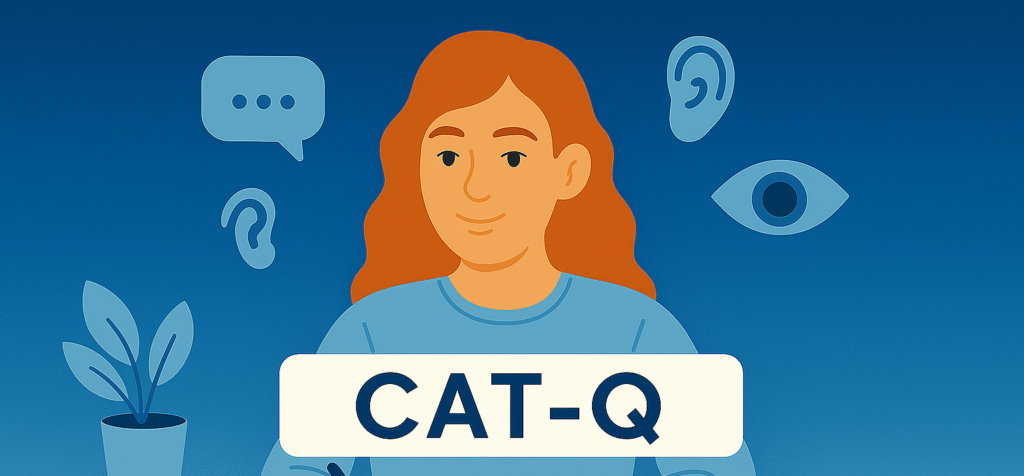CAT-Q

What is the CAT-Q?
The Camouflaging Autistic Traits Questionnaire (CAT-Q) is a specialised self-assessment designed to explore the subtle and often unconscious behaviours that individuals use to mask or adapt their autistic traits in social settings. These behaviours, commonly known as camouflaging, can include suppressing natural responses, mimicking neurotypical communication styles, or employing learned coping strategies to avoid standing out or to meet perceived social expectations.
Camouflaging is particularly common among autistic women and adults, many of whom may go undiagnosed due to their ability to blend in. While these strategies can help people navigate daily interactions, they often come at a cost, such as increased stress, anxiety, and emotional exhaustion.
This questionnaire offers a window into how you may be adapting your behaviour, helping you identify patterns that may be affecting your mental health, relationships, and sense of self. By recognising these tendencies, you can begin to explore more authentic ways of engaging with the world, on your own terms.
How are CAT-Q scores interpreted?
- A score of 100 and above suggests camouflaging
- The greater the score the higher the extent of camouflaging traits
- A study found that autistic females had significantly higher scores than autistic males
- Autistic females scored an average of 124
- Autistic males scored an average of 109
- A score of below 100 suggests lower camouflaging
Why Should You Take the CAT-Q?
The CAT-Q test is perfect if you’ve ever felt like you “hide” parts of yourself to fit in socially. Here’s why it’s so beneficial:
- Self-Discovery: Learn how camouflaging behaviours might be impacting your social interactions.
- Unique Focus: Unlike other autism screening tools, the test specifically addresses masking strategies.
- Improved Awareness: Understanding your behaviours can lead to healthier coping mechanisms and better self-acceptance.
- Empowering Results: With a clearer picture of your tendencies, you’ll know whether further exploration or support is needed.
How Does the CAT-Q Work?
The test is a simple and easy-to-use questionnaire:
- Answer Questions About Social Behaviours: Reflect on how you adapt or suppress traits in different settings.
- Get Detailed Results: Your scores will highlight levels of camouflaging across three key areas:
- Compensation: Efforts to make up for perceived deficits.
- Masking: Hiding traits to appear more neurotypical.
- Assimilation: Changing behaviour to fit into social groups.
- Take the Next Step: Use your results to better understand yourself and, if needed, consult a specialist.
Other Tests You Might Find Helpful
Autism Quotient (AQ) Test
Explore traits associated with autism spectrum conditions, including communication style, social interaction, and repetitive behaviours.
👉 Take the AQ Test
Empathy Quotient (EQ) Test
Discover how well you recognise and respond to the emotions of others. This test explores emotional understanding and empathy in the context of autism.
👉 Take the EQ Test
RAADS-R Test
Gain a deeper understanding of lifelong autism traits with this detailed screening tool designed for adults.
👉 Take the RAADS-R Test
FAQ Section: CAT-Q Test
1. What does the CAT-Q measure?
This test evaluates camouflaging behaviours, such as suppressing autistic traits, imitating neurotypical behaviours, and adapting to fit social expectations.
2. How long does the CAT-Q test take?
Most people complete the test in about 10–15 minutes.
3. Is the CAT-Q test free?
Yes, the test is completely free to access on NeuroDirect.
4. Can the CAT-Q diagnose autism?
No, the test is a screening tool that focuses on camouflaging behaviours. For a formal diagnosis, you’ll need to consult a specialist.
5. What should I do after taking the CAT-Q test?
If your results indicate significant camouflaging behaviours, consider using NeuroDirect’s Find a Specialist tool to connect with professionals who can offer guidance or support.
References
For a deeper dive into what camouflaging means in autism and how the CAT-Q works, check out this overview by Embrace Autism.
